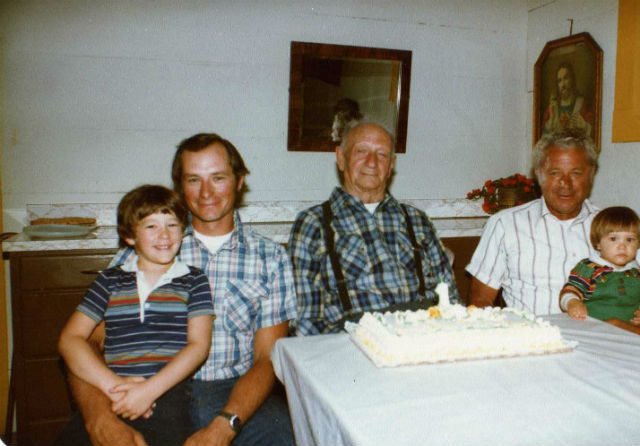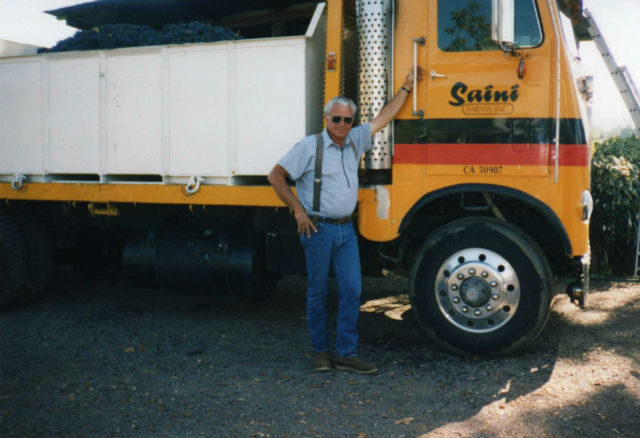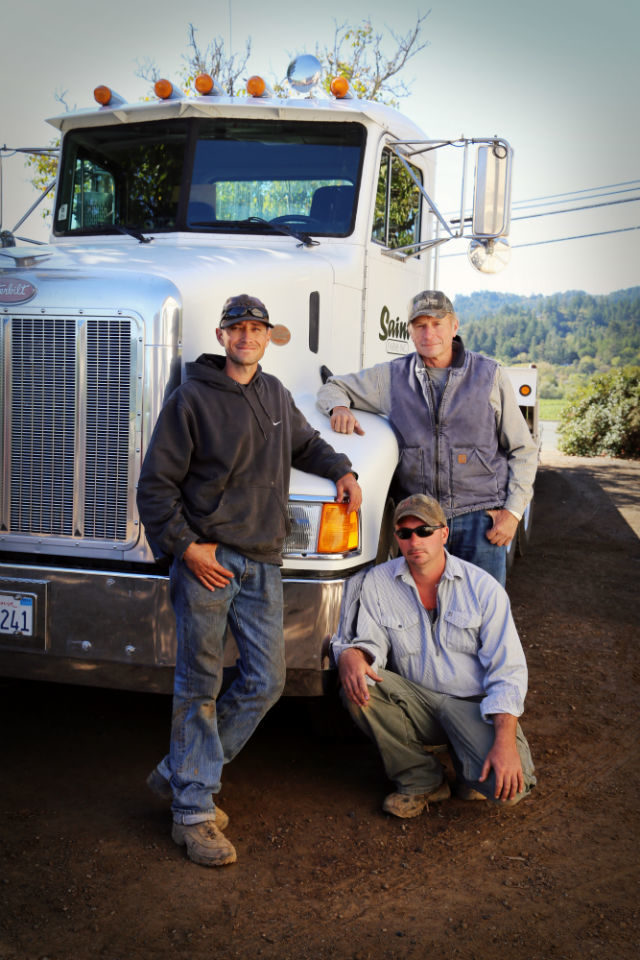By Laura Ness
 Third generation grape grower, John Saini and his sons, Brian and Mike, of Saini Farms, wear their farming hearts humbly on their sleeves. There’s little doubt they spend their lives tending to 300 acres of land that has been a precious part of the family, going back to 1917. While most of their holdings, 200 acres of which are planted to grapes, are located in the Dry Creek Valley, they also own land in Alexander Valley, where Brian lives with his family. Four generations of Saini’s have lived and farmed here, beginning with John’s grandfather, Michele, who arrived here from Italy in 1908, initially finding work as a garbage collector and salvage specialist in San Francisco. Like many Italian immigrants of the time, he longed to live off the land, but first had to make enough money to purchase some.
Third generation grape grower, John Saini and his sons, Brian and Mike, of Saini Farms, wear their farming hearts humbly on their sleeves. There’s little doubt they spend their lives tending to 300 acres of land that has been a precious part of the family, going back to 1917. While most of their holdings, 200 acres of which are planted to grapes, are located in the Dry Creek Valley, they also own land in Alexander Valley, where Brian lives with his family. Four generations of Saini’s have lived and farmed here, beginning with John’s grandfather, Michele, who arrived here from Italy in 1908, initially finding work as a garbage collector and salvage specialist in San Francisco. Like many Italian immigrants of the time, he longed to live off the land, but first had to make enough money to purchase some.
Dry Creek Valley, with its abundant fruit orchards, vineyards and natural beauty appealed then, as now. An air of timeless tranquility pervades. Everywhere you look, you see tractors, balers, bins, pickup trucks dented and dinged by use and abuse, not covered in trophy mud from an excursion on the Rubicon Trail. This is the real deal. Grapes are glamorous only to those who drink, unaware, from bejeweled goblets, far from the dust and dirt, heat and sweat, fog and chill.
We are sitting in the brand new Saini tasting room, on Dry Creek Road, opened in June of 2019, a scant mile or so from the freeway, but a world away from the downtown bustle. To the east, vineyards trace the steep hills, hugging them tightly like old friends. Here, the Saini’s grow Zinfandel, as they have for three generations. To the west, across the road, their Sauvignon Blanc vineyard sits in a swale, looking up at dramatic hills with equally dramatic homes.
Although they doubtless didn’t consult each other on apparel, they look the model farming family in their matching striped shirts, their bulky two-way radios, their well-worn, calloused hands and their handsome weather-tanned faces.

Four Generations from left Mike, John, Michele, Eugene “Si”, and Brian Saini
It wasn’t always a sea of grapes out here. In fact, when Michele, purchased land here in Dry Creek in 1917, the primary crop was prunes. In fact, John’s wife, Patti’s family, who is from Healdsburg, invented the popular prune dryers of the day. But tastes in agriculture are fickle. Nothing seems to be in style forever. After plums, came pears, then apples. Turkey and chicken farms were also in abundance. John remembers when a combination of walnuts, apples, pears and poultry were profitable. He also recalls the enormous vegetable garden that his grandparents had. It’s now a swimming pool.
But then came the wave of grapes, and some might say, the flood. John worries about the surplus of grapes, and the impact of large wineries canceling contracts. All three worry about pricing and the threat of consolidation, with so many conglomerates buying out brands.
Some long-time neighbors are selling off land: it’s at a premium. Who can blame them? But selling out is not John Saini’s way. The land defines this family and there is nothing but honor and pride in such a definition. In fact, he doubled down on the importance of grape farming by building this very tasting room. “I did it for the whole family, and for the next generation, for Mike and Brian’s kids,” says John. “Patti and I wanted them to have a legacy.”
But it was a nerve-wracking process that took five long years and was delayed 1.5 years by an egregious design error made by a supplier. “This is the hardest project I’ve ever undertaken,” he admits, “But we figured we better get it done before it becomes impossible.” The project took so long, they went through three different planners at the county, each with their own spin on things. John sighs in recollection of lost time and money. “We’re farmers, not developers.”
The custom design for the very high open ceiling, which required 5” insulation, was somehow misinterpreted when the roof was constructed in Texas. “Three flatbed trucks show up from Texas with the roof, but it was all wrong.” He looks up at the ceiling as if to reassure himself that it did, indeed, come together after all. “When you’re a do-it-yourself farmer, it’s hard to leave something to someone else’s hands.”
He speaks with reverence on the long-term relationship his father established with the Seghesio family, to whom they’ve been selling Zinfandel grapes for decades. However, it took a while. Observes John, “When you have a winery that tells you how to farm your vineyard, it can be very frustrating. But having a partner with whom you can work together, can be very rewarding.”

Eugene “Si” Saini
Mike, who is in charge of the vineyard contracts and labor, explains that they have a very specific way of farming the head-trained old vines to meet the Seghesio’s requirements. Essentially, through careful pruning, shoot thinning and fruit dropping, they create a “sun umbrella” that shades the fruit on the east side. “We perform 180-degrees of leafing around the clusters,” explains Mike. “We have only one cluster per shoot on some vines. We do multiple fruit drops to ensure quality. No clusters should be touching. At 90% veraison, all green bunches are dropped.”
It’s counterintuitive to a farmer to drop perfectly good fruit. Advises John, “You have to train yourself not to look at the grounds. Instead, look at what is left on the vine.”
John also comments on the intense labor investment, noting, “The only problem with this approach is it requires specific training of your vineyard crew. You can ruin an entire vineyard in one hour with the wrong help. It’s a very nerve-wracking time.” Fortunately, they have great help, some of whom, like George Minaglia, have been with them over 25 years, as well as Fidel Carrillo and Mario Moreno, who have assisted with multiple aspects of the Saini operation for over 10 years.
Still, you can do everything right, and still get screwed. In 2010, John recalls, Pete Seghesio told them the vineyard looked better than it had in 25 years. “Best job ever!” And then they got hit with a huge heat wave and ended up losing 75% of the crop.
Mike notes that Zinfandel is particularly problematic to grow. “It’s either red, rot, or raisin.” To achieve the quality they and their customers want, they sort in the field. “I can brag about this. We have a 12-person crew and 3 sorters, and we strip leaves, botrytis, anything we don’t want out, before it even gets to the stainless steel sorting table.”
Besides Zinfandel and Sauvignon Blanc, the Saini’s grow Carignane, Cabernet Sauvignon, Sangiovese, Grenache, Chardonnay, Merlot and Syrah. Currently, the family sells fruit to some 22 different wineries, including Alexander Valley Vineyards, Bannister, Benziger, Draxton, Passalacqua, Seghesio and Silver Oak. They even sold some Cinsault to Randall Grahm of Bonny Doon in the past.
They’ve been making their own wine since 2008, mostly Zinfandel, for which they’ve established a good local market presence. The Saini White Label Zin can be found at Whole Foods, and a dozen other retail outlets. Most recently, they engaged the winemaking services of Julia Iantosca and Jeff McBride, longtime industry veterans (Dry Creek Vineyards, Lambert Bridge, Lasseter Family Winery). The wines are made at Grand Cru, and are an impressive lot.

“Si” in His Later Days
Begin with the bright, crisp, lime and lemongrass-laden Sauvignon Blanc, and the uber clean as a whistle rosé of Carignane, Grenache and Sangiovese, a refreshing wave of strawberry-kiwi. It’s called Valentina Marie for Mike’s daughter. Lovers of Carignane will be taken by the gorgeous color and clarity of the peppery, raspberry-filled freshness of the 2018, and those who appreciate blends will find the 2018 Angelo’s Paintbrush, named for Mike’s young son, a most fetching amalgamation of Carignane, Sangiovese and Grenache. Packed with bright cherry and raspberry, fresh acidity and a modicum of white pepper, this is Mike and John’s hands-down favorite. “I’m in love with Sangiovese!” says Mike.
And yet, the family flagship was and always will be Zinfandel. In addition to the white label, they also make three vineyard block designates, each named for an historical aspect of the property. There’s the Olive block Zin, with wild cherry and green olive, the Pear block and the Apple Block, sporting blueberry, pomegranate and basil. All have ample acid and show judicious use of oak, framing the fruit like the windows of the tasting room frame the vineyards.
John explains that these steep blocks were originally planted to Zin, going back to 1917, with 12ft spacing to accommodate a horse and plough. It was abandoned for 30 years, but replanted in 1990, using the same 12ft spacing. They planted some Cab Franc which was popular with Dry Creek Vineyard for a while, but they eventually grafted it over to Zin, due to virus. Plus, the demand for old vine Zin is strong.
All three fervently hope it remains that way. In a world that is changing so rapidly, it’s scarcely recognizable to folks who don’t center their lives around technology. They worry about the intense shortage of labor, and the competition from the cannabis industry. They also wonder if their kids will choose this path. Who will want to put in the toil and tears required to farm? They’ve known no other way of life.
John shares a story about being downtown and watching young kids play a game with a map of the US, where they stepped on each state they’d been to. He marveled at how many places these kids had been. “Me? I’ve been to two.” His sons could top that by one each. Asked if they’d ever been to Italy to the birthplace of Michele Saini, John’s grandfather, they all shake their heads. Getting on a plane just doesn’t appeal. Dealing with the dizzying cacophony of an airport and all the hassle of rental cars and booking hotels simply holds no charm to those who live on a farm.
So, without travel, which fills most bucket lists, what do these guys want to accomplish? Both John and Brian express the desire to create a plaque to honor John’s uncle, a young man who lost his life in the Pacific Theater in World War II. His remains were recently brought back and they want to create a fitting memorial to the ultimate sacrifice a family member made to preserve the freedom they hold so dear.
Another bucket list item? John mentions that his wife Patti wants to restore an old 1926 Dodge touring car that’s currently stuck in the barn. They hope to give tours around the vineyard property and had planned the restoration once the tasting room was complete, but all the delays and extra fees they had to pay as the project dragged on, tapped their savings.

Brian, Mike and John Saini
Still, there’s hope. John is teaching Brian’s daughters how to drive an old stick shift Jeep. Although they’re seriously into soccer right now, who knows? They might be tempted to follow an agrarian lifestyle and stay home on the farm. Mike and Brian chuckle as they remember the time they were first learning to drive with their grandfather, Eugene, and suddenly, the rear tire went rolling down the hill in front of them. “We better fix that before your Dad sees it!” Mike recalls his grandfather saying.
Asked how they would define success with the tasting room, John answers that he wants to build relationships, give people a chance to connect with the land, take a walk in the vineyards and appreciate where the wine came from. “We’ll be successful if we have lots of happy repeat customers. We’ve already had club members build us tables and send wooden toy cars for kids to play with. People are happy to come here.”
And in that frank, no BS manner, he looks me in the eye and says, “The way I look at this, if we’re not having fun, we’re done!”
Come out to the Saini tasting room and taste the fruits of all that labor for yourself. You’ll be glad you did.
The tasting room is open Thursday through Sunday, from noon until 4:30pm at 2507 Dry Creek Road, Healdsburg.
















